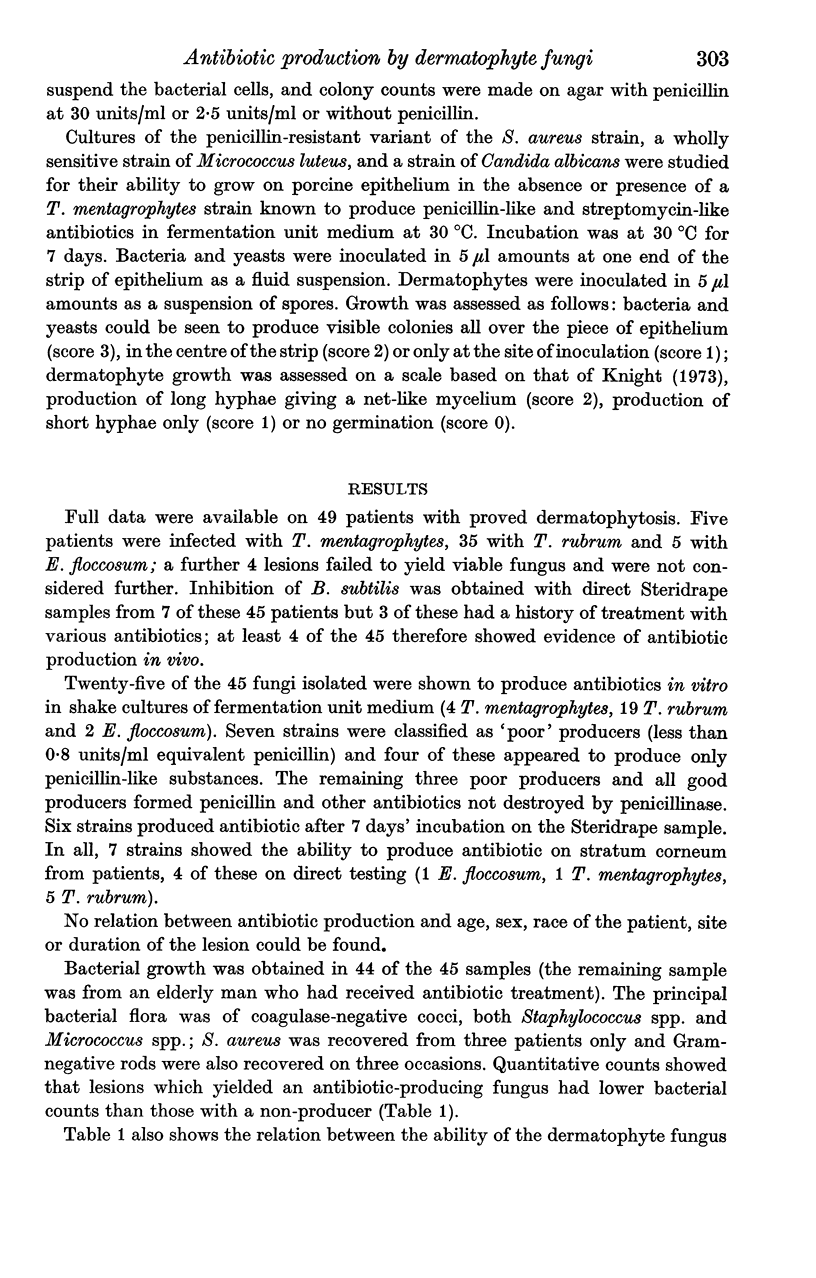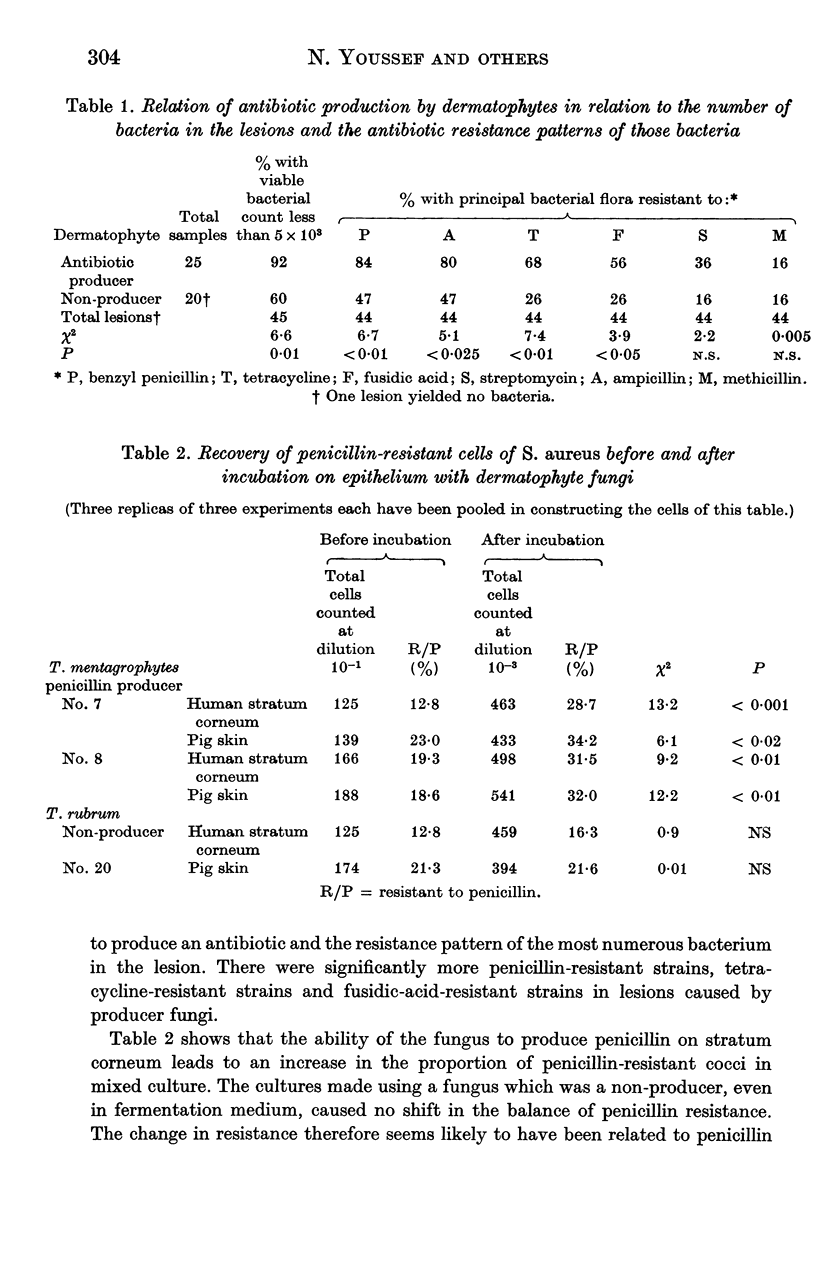Abstract
Antibiotic production by dermatophyte fungi has been demonstrated in vivo in the lesions of patients with dermatomycoses. Patients infected with antibiotic-producing strains more frequently carried cocci resistant to penicillin and other antibiotics than did patients infected with non-producer strains. The total bacterial load was less in lesions caused by producer fungi. In vitro studies demonstrated the selection of penicillin-resistant S. aureus from mixed populations of resistant and sensitive cells.
Full text
PDF






Selected References
These references are in PubMed. This may not be the complete list of references from this article.
- Arvidson S., Holme T., Lindholm B. The formation of extracellular proteolytic enzymes by Staphylococcus aureus. Acta Pathol Microbiol Scand B Microbiol Immunol. 1972;80(6):835–844. doi: 10.1111/j.0365-5563.1973.tb00009.x. [DOI] [PubMed] [Google Scholar]
- Bibel D. J., LeBrun J. R. Effect of experimental dermatophyte infection on cutaneous flora. J Invest Dermatol. 1975 Feb;64(2):119–123. doi: 10.1111/1523-1747.ep12510335. [DOI] [PubMed] [Google Scholar]
- King R. D., Dillavou C. L., Greenberg J. H., Jeppsen J. C., Jaegar J. S. Identification of carbon dioxide as a dermatophyte inhibitory factor produced by Candida albicans. Can J Microbiol. 1976 Dec;22(12):1720–1727. doi: 10.1139/m76-254. [DOI] [PubMed] [Google Scholar]
- Knight A. G. Human models for in vivo and in vitro assessment of topical antifungal compounds. Br J Dermatol. 1973 Nov;89(5):509–514. doi: 10.1111/j.1365-2133.1973.tb03013.x. [DOI] [PubMed] [Google Scholar]
- LITTMAN M. L., MIWATANI T. EFFECT OF WATER SOLUBLE VITAMINS AND THEIR ANALOGUES ON THE GROWTH OF CANDIDA ALBICANS. I. BIOTIN, PYRIDOXAMINE, PYRIDOXINE AND FLUORINATED PYRIMIDINES. Mycopathol Mycol Appl. 1963 Dec 15;21:81–108. doi: 10.1007/BF02049170. [DOI] [PubMed] [Google Scholar]
- MARPLES M. J., BAILEY M. J. A search for the presence of pathogenic bacteria and fungi in the interdigital spaces of the foot. Br J Dermatol. 1957 Nov;69(11):379–388. doi: 10.1111/j.1365-2133.1957.tb13778.x. [DOI] [PubMed] [Google Scholar]
- Minocha Y., Pasricha J. S., Mohapatra L. N., Kandhari K. C. Proteolytic activity of dermatophytes and its role in the pathogenesis of skin lesions. Sabouraudia. 1972 Mar;10(1):79–85. doi: 10.1080/00362177285190161. [DOI] [PubMed] [Google Scholar]
- Noble W. C. Variation in the prevalence of antibiotic resistance of Staphylococcus aureus from human skin and nares. J Gen Microbiol. 1977 Jan;98(1):125–132. doi: 10.1099/00221287-98-1-125. [DOI] [PubMed] [Google Scholar]
- SMITH J. M., MARPLES M. J. DERMATOPHYTE LESIONS IN THE HEDGEHOG AS A RESERVOIR OF PENICILLIN-RESISTANT STAPHYLOCOCCI. J Hyg (Lond) 1965 Jun;63:293–303. doi: 10.1017/s0022172400045174. [DOI] [PMC free article] [PubMed] [Google Scholar]
- Schönborn C. Uber Mischinfektionen bei Onychomykosen. Arch Klin Exp Dermatol. 1968;232(1):1–15. [PubMed] [Google Scholar]
- URI J., SZATHMARY S., HERPAY Z. Production of an antibiotic by dermatophytes living in horn products. Nature. 1957 May 18;179(4568):1029–1030. doi: 10.1038/1791029b0. [DOI] [PubMed] [Google Scholar]
- URI J., SZATHMARY S., HERPAY Z. Uber die Antibioticaproduktion von Pilzen am Ort ihres natürlichen Vorkommens; der Nachweis der Antibioticaproduktion von in Horngebilden lebenden Dermatophyten. Pharmazie. 1957 Aug;12(8):485–488. [PubMed] [Google Scholar]


